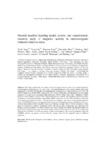General machine learning model, review, and experimental-theoretic study of magnolol activity in enterotoxigenic induced oxidative stress

Ver/
Use este enlace para citar
http://hdl.handle.net/2183/22817Coleccións
- GI-RNASA - Artigos [195]
- INIBIC-RNASA-IMEDIR - Artigos [47]
Metadatos
Mostrar o rexistro completo do ítemTítulo
General machine learning model, review, and experimental-theoretic study of magnolol activity in enterotoxigenic induced oxidative stressAutor(es)
Data
2017Cita bibliográfica
DengY, Liu Y, Tang S, et al. General machine learning model, review, and experimental-theoretic study of magnolol activity in enterotoxigenic induced oxidative stress. Curr Top Med Chem. 2017; 17(26): 2977-2988
Resumo
[Abstract] This study evaluated the antioxidative effects of magnolol based on the mouse model induced by Enterotoxigenic Escherichia coli (E. coli, ETEC). All experimental mice were equally treated with ETEC suspensions (3.45×109 CFU/ml) after oral administration of magnolol for 7 days at the dose of 0, 100, 300 and 500 mg/kg Body Weight (BW), respectively. The oxidative metabolites and antioxidases for each sample (organism of mouse) were determined: Malondialdehyde (MDA), Nitric Oxide (NO), Glutathione (GSH), Myeloperoxidase (MPO), Catalase (CAT), Superoxide Dismutase (SOD), and Glutathione Peroxidase (GPx). In addition, we also determined the corresponding mRNA expressions of CAT, SOD and GPx as well as the Total Antioxidant Capacity (T-AOC). The experiment was completed with a theoretical study that predicts a series of 79 ChEMBL activities of magnolol with 47 proteins in 18 organisms using a Quantitative Structure- Activity Relationship (QSAR) classifier based on the Moving Averages (MAs) of Rcpi descriptors in three types of experimental conditions (biological activity with specific units, protein target and organisms). Six Machine Learning methods from Weka software were tested and the best QSAR classification model was provided by Random Forest with True Positive Rate (TPR) of 0.701 and Area under Receiver Operating Characteristic (AUROC) of 0.790 (test subset, 10-fold crossvalidation). The model is predicting if the new ChEMBL activities are greater or lower than the average values for the magnolol targets in different organisms.
Palabras chave
QSAR models
Magnolol
Antioxidative activity
Reactive oxygen species
Machine learning
Random forest
Magnolol
Antioxidative activity
Reactive oxygen species
Machine learning
Random forest
Versión do editor
Dereitos
The published manuscript is avaliable at Eureka Select
ISSN
1568-0266





